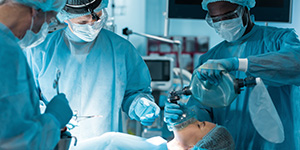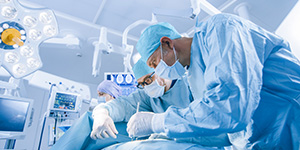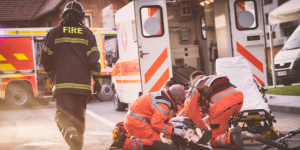In the operating room, every detail matters. The pursuit of better patient outcomes drives innovation across every aspect of care. Often overlooked, but among the most critical elements, is patient positioning. Improper positioning leads to a laundry list of preventable complications that includes nerve damage, skin injuries, and hypothermia. These challenges are especially pronounced in lengthy procedures and with complex positioning, such as the steep Trendelenburg. SourceMark Medical’s Opt-Shield was created and developed to address these very issues. It’s an integrated solution designed to enhance patient safety, improve clinical efficiency, and support better patient outcomes. By combining secure positioning with active warming in a single, streamlined system, the Opt-Shield offers a new standard of care for a wide range of surgical procedures.
Understanding Surgical Positioning: Trendelenburg vs. Supine
To appreciate the need for advanced positioning solutions, it’s important to understand the fundamental positions used in surgery and their associated risks.
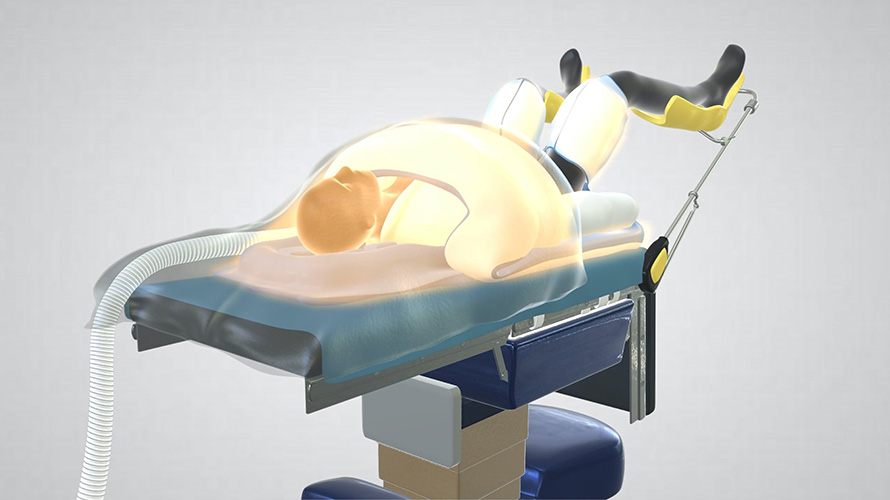
-
- Trendelenburg Position: In this position, the table is tilted so the patient’s head is lower than their feet. The “steep” Trendelenburg, often required for robotic-assisted pelvic and lower abdominal surgeries, involves a tilt of up to 45 degrees. This steep angle is necessary to use gravity to move the abdominal organs away from the surgical site, providing the surgeon with a clear view. However, this position significantly increases the risk of the patient sliding on the table, which can cause friction and shearing injuries to the skin and underlying tissues, as well as potential nerve damage.
- Supine Position: This is the most common surgical position where the patient lies flat on their back. While it seems straightforward, risks still exist, especially for patients with a high BMI. Gravity can cause tissue to shift, and prolonged pressure on key areas can lead to skin breakdown or nerve injury.
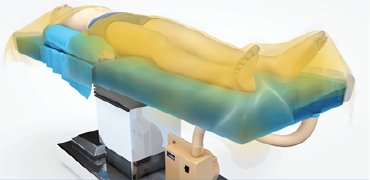
The Risks of Inadequate Positioning and Warming
During any surgical procedure, but especially in complex positions, patients face several potential hazards. The Opt-Shield is engineered to mitigate these risks collaboratively.
- Patient Sliding and Skin Injury: In the steep Trendelenburg position, the force of gravity is immense. Without a secure positioning system, patients can slide, leading to skin shearing, a painful injury where layers of skin and tissue are forced to slide across each other.
- Nerve Damage: Improper arm positioning can lead to brachial plexus injury, a serious complication causing pain, weakness, or paralysis in the arm and hand. Additionally, sliding can put undue pressure on other nerve bundles.
- Hypothermia: Maintaining a patient’s core body temperature (normothermia) is crucial and cannot be understated. Anesthesia inhibits the body’s ability to regulate temperature. Subsequently, even a mild drop can lead to increased infection rates, delayed wound healing, and adverse cardiac events.
- Inefficiency and Staff Injury: Traditional positioning methods often involve a patchwork of foam, gel pads, and tape. Assembling these materials is time-consuming and can lead to inconsistent application. Furthermore, manually repositioning a sliding patient mid-procedure puts OR staff at risk for back injuries.
Key Features of the Opt-Shield
The Opt-Shield is designed as a comprehensive system that addresses these challenges through an innovative, all-in-one design. It provides a platform for partnership between the surgical team and the technology, fostering a safer environment.
Its core features include:
- Secure Positioning: The system securely cradles the patient, providing stability in both supine and steep Trendelenburg positions. This design has been shown to eliminate patient sliding, thereby protecting against skin shearing.
- Brachial Plexus Protection: Integrated arm protectors help maintain the arms in a safe, neutral position, significantly reducing the risk of nerve compression and injury.
- Streamlined Line Management: The design includes organized channels for IV lines and monitoring cables, preventing tangles and disconnections during the procedure.
- Efficient Setup: Because it is a single, integrated system, Opt-Shield dramatically reduces the time and effort required to position a patient. Thus, the setup is intuitive and consistent every time.
- Integrated Forced-Air Warming: Opt-Shield uniquely incorporates channels for total-body forced-air warming. It distributes warm air over and under the patient, covering a large body surface area to effectively maintain normothermia.
Enhanced Patient Warming: The Perfect Pairing with KoZee
An added advantage is how seamlessly the Opt-Shield pairs with SourceMark’s KoZee convective patient warming system. The KoZee system’s advanced convective warming technology complements the integrated capabilities of the Opt-Shield. It provides consistent regulation of normothermia and enhances patient comfort. Together, they create a supportive environment that contributes to safer outcomes, smoother workflows, and shared success across the operating team. The versatility of the Opt-Shield makes it a valuable tool for a variety of procedures and patient populations.
- Robotic-Assisted Surgery (Steep Trendelenburg): For gynecologic, urologic, and colorectal procedures, where a steep angle is essential, SourceMark’s Opt-Shield provides the security needed to keep patients stable throughout long procedures.
- General and Bariatric Surgery (Supine): For patients in the supine position, particularly those with a high BMI, the system offers stable positioning and helps manage tissue distribution, in addition to providing effective warming.
The Power of a Single SKU: Operational and Economic Wins
Beyond its clinical benefits, SourceMark’s Opt-Shield transforms supply chain management. Traditional positioning requires sourcing, stocking, and assembling multiple different items such as various pads, straps, and warming blankets. Each of these are its own stock-keeping unit (SKU) which creates complexity and waste.
Consolidating these components into one SKU offers powerful advantages including:
- Faster Room Turnover: With a single system to place, setup is quicker and more predictable. This allows teams to prepare the OR for the next case more rapidly, improving overall throughput.
- Reduced Inventory Complexity: Managing one SKU instead of five or more simplifies ordering, storage, and inventory management, freeing up valuable supply room space and staff time.
- Standardized Practice: A single solution ensures every patient receives the same high standard of positioning care, reducing variability and improving safety protocols.
- Fewer Supply Touches: An all-in-one system reduces the number of individual items that need to be handled, thus lowering the risk of contamination and supporting infection control initiatives.
- Potential Cost Savings: While consolidating supplies, hospitals may also see cost benefits through reduced product waste, optimized inventory, and improved OR efficiency.
Advancing the Standard of Surgical Care Together
Every healthcare professional’s goal is to provide the safest and most effective care possible. Achieving this requires a combination of skilled hands and innovative tools that support best practices. SourceMark Medical’s Opt-Shield represents a forward-thinking approach to patient safety, directly addressing the known risks of surgical positioning and hypothermia. By integrating security, warming, and efficiency into a single platform, it empowers clinical teams to protect their patients while optimizing their workflow.
Are you looking to elevate patient safety and drive efficiency in your operating rooms? Contact us today and explore further how the Opt-Shield can become a valued partner in your commitment to clinical excellence.




